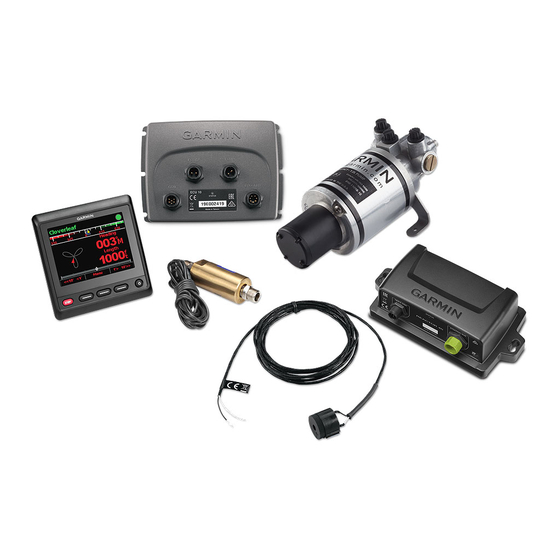Garmin Reactor 40 Посібник з конфігурації - Сторінка 7
Переглянути онлайн або завантажити pdf Посібник з конфігурації для Морське обладнання Garmin Reactor 40. Garmin Reactor 40 8 сторінок. Mechanical
Також для Garmin Reactor 40: Інструкція з монтажу Посібник з монтажу (11 сторінок), Інструкція з монтажу Посібник з монтажу (13 сторінок), Інструкція з монтажу Посібник з монтажу (29 сторінок), Інструкція з монтажу Посібник з монтажу (25 сторінок)

Multiple Sources of Sensor Information
There may be multiple sources of sensor information available to the autopilot system. If so, you can select a
preferred data source.
For example, because GPS speed from an external antenna is more reliable and accurate than that from an
integrated GPS receiver inside a chartplotter, you should select the external GPS antenna as the preferred
source of GPS data. Also, because it can be difficult to find an ideal mounting location for the autopilot CCU, you
can optionally select an external NMEA 2000 GPS compass or other heading sensor as the preferred source of
heading data.
Selecting a Preferred Source of Sensor Information
1 On a helm control or the autopilot screen on a chartplotter, select
NOTE: Some items in the Preferred Sources menu are shown only when multiple sensors providing the same
data are available to the system.
2 Select a data category.
3 Select a source.
Detailed Configuration Settings
Although all of the configuration is typically completed automatically through wizards, you can manually adjust
any setting to fine-tune the autopilot.
NOTE: Depending upon the configuration of the autopilot, certain settings may not appear.
NOTE: Each time you change the Speed Source setting, you must review the Low RPM Limit, High RPM Limit,
or Max. Speed settings, where applicable, and you must perform the autotune procedure again
Autotune Procedure,
page 4).
Autopilot Tuning Settings
On a helm control or the autopilot screen on a chartplotter, select
Setup > Autopilot Tuning.
Autotune: Starts the Autotune procedure
Rudder Gains: Adjusts the rudder-gain settings
Accel. Limiter: Allows you to limit the speed of autopilot-controlled turns. You can increase the percentage to
limit the turn rate, and decrease the percentage to allow a higher turn rate.
Speed Source Settings
On a helm control or the autopilot screen on a chartplotter, select
Setup > Speed Source Setup.
Speed Source: Allows you to select the speed source.
Low RPM Limit: Allows you to adjust the lowest RPM point of your boat. If the value does not match the value
on the helm control or chartplotter, you can adjust the value.
High RPM Limit: This setting should be 6000 RPM.
Max. Speed: Allows you to enter the maximum speed of the boat when powered by the kicker motor only.
Rudder Gain Settings
NOTE: If you set these values too high or too low, the autopilot may become overactive, attempting to
constantly adjust the heading at the slightest deviation. An overactive autopilot can cause excess wear on
the pump and drain the battery at a faster-than-normal rate.
On a helm control or the autopilot screen on a chartplotter, select
Setup > Autopilot Tuning > Rudder Gains.
Gain: Allows you to adjust how tightly the rudder holds a heading and makes turns.
Counter Gain: Allows you to adjust how tightly the rudder corrects turn overshoot. If you set this value too low,
the autopilot can overshoot a turn when attempting to counter the original turn.
(Performing the Autotune Procedure,
(Rudder Gain Settings,
> Autopilot Setup > Preferred Sources.
> Autopilot Setup > Autopilot Installation
page 4).
page 7).
> Autopilot Setup > Autopilot Installation
> Autopilot Setup > Autopilot Installation
(Performing the
7
